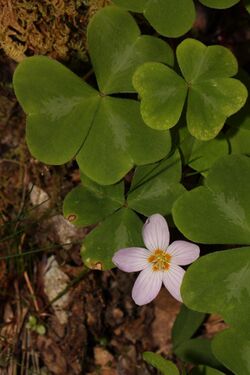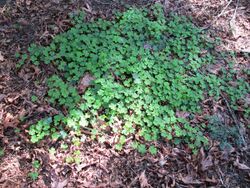Biology:Oxalis oregana
| Oxalis oregana | |
|---|---|

| |
| Redwood sorrel | |
| Scientific classification | |
| Kingdom: | Plantae |
| Clade: | Tracheophytes |
| Clade: | Angiosperms |
| Clade: | Eudicots |
| Clade: | Rosids |
| Order: | Oxalidales |
| Family: | Oxalidaceae |
| Genus: | Oxalis |
| Species: | O. oregana
|
| Binomial name | |
| Oxalis oregana Nutt.
| |
Oxalis oregana , known as redwood sorrel or Oregon oxalis, is a species of the wood sorrel family, Oxalidaceae, in the genus Oxalis native to moist Douglas-fir and coast redwood forests of western North America from southwestern British Columbia to Washington (state) , Oregon, and California .[1][2]
Description

Oxalis oregana is a short, herbaceous perennial with erect flowering stems 5–15 cm tall. The three leaflets are heart-shaped, 1–4.5 cm long with purplish undersides, on 5–20 cm stalks. The inflorescence is 2.4–4 cm in diameter, white to pink with five petals and sepals. The hairy five-chambered seed capsules are egg-shaped, 7–9 mm long; seeds are almond-shaped.[3] It spreads by a scaly rhizome varying the size of patches. They can be seen throughout moist forest under-canopies.[4]
Rapid light response

Oxalis oregana photosynthesizes at relatively low levels of ambient sunlight (1/200th of full sunlight). When direct sunlight strikes the leaves they fold downwards; when shade returns, the leaves reopen. Taking only a few minutes, this movement is observable to the eye.[5][6]
As food
The leaves of Oxalis oregana were eaten by the Cowlitz, Quileute and Quinault peoples. Like spinach, they contain mildly toxic oxalic acid, which is named after the genus.[7] They are safe to eat in small amounts for those with no oxalate-related conditions.[8]
References
| Wikimedia Commons has media related to Oxalis oregana. |
- ↑ "WTU Herbarium Image Collection". http://biology.burke.washington.edu/herbarium/imagecollection.php?Genus=Oxalis&Species=oregana.
- ↑ "Plants Profile for Oxalis oregana (redwood-sorrel)". http://plants.usda.gov/core/profile?symbol=OXOR.
- ↑ "Nyctinasty and Mimosa leaf movement". http://www.saps.org.uk/saps-associates/browse-q-and-a/426-nyctinasty-and-mimosa-leaf-movement.
- ↑ "Burke Herbarium Image Collection". https://biology.burke.washington.edu/herbarium/imagecollection/taxon.php?Taxon=Oxalis%20oregana.
- ↑ "Oxalis oregana". http://linnet.geog.ubc.ca/Atlas/Atlas.aspx?sciname=Oxalis+oregana.
- ↑ "12.1.1 Light interception and utilisation". http://plantsinaction.science.uq.edu.au/edition1/?q=content/12-1-1-light-interception-and-utilisation.
- ↑ Pojar, Jim; Andy MacKinnon (2004). Plants Of The Pacific Northwest Coast: Washington, Oregon, British Columbia & Alaska. Lone Pine Publishing. ISBN 978-1-55105-530-5.
- ↑ Benoliel, Doug (2011). Northwest Foraging: The Classic Guide to Edible Plants of the Pacific Northwest (Rev. and updated ed.). Seattle, WA: Skipstone. pp. 175. ISBN 978-1-59485-366-1. OCLC 668195076. https://www.worldcat.org/oclc/668195076.
Wikidata ☰ Q953836 entry
 |

